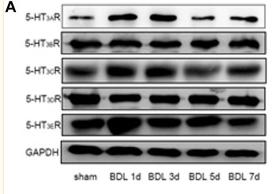HTR3E Antibody - #DF2708
| Product: | HTR3E Antibody |
| Catalog: | DF2708 |
| Description: | Rabbit polyclonal antibody to HTR3E |
| Application: | WB IHC |
| Cited expt.: | WB |
| Reactivity: | Human |
| Mol.Wt.: | 51kDa; 51kD(Calculated). |
| Uniprot: | A5X5Y0 |
| RRID: | AB_2839914 |
Product Info
*The optimal dilutions should be determined by the end user. For optimal experimental results, antibody reuse is not recommended.
*Tips:
WB: For western blot detection of denatured protein samples. IHC: For immunohistochemical detection of paraffin sections (IHC-p) or frozen sections (IHC-f) of tissue samples. IF/ICC: For immunofluorescence detection of cell samples. ELISA(peptide): For ELISA detection of antigenic peptide.
Cite Format: Affinity Biosciences Cat# DF2708, RRID:AB_2839914.
Fold/Unfold
5-HT-3; 5-HT3 receptor subunit E splice variant HTR3Ea; 5-HT3c1; 5-HT3E; 5-HT3R; 5-hydroxytryptamine (serotonin) receptor 3, family member E; 5-hydroxytryptamine receptor 3 subunit E; 5-hydroxytryptamine receptor 3E; 5HT3c1; 5HT3E; 5HT3R; HTR3; MGC120035; MGC120036; MGC120037; SEROTONIN 5-HT-3E RECEPTOR; serotonin receptor 3 subunit E; Serotonin receptor 3E;
Immunogens
A synthesized peptide derived from human HTR3E, corresponding to a region within the internal amino acids.
- A5X5Y0 5HT3E_HUMAN:
- Protein BLAST With
- NCBI/
- ExPASy/
- Uniprot
MEGSWFHRKRFSFYLLLGFLLQGRGVTFTINCSGFGQHGADPTALNSVFNRKPFRPVTNISVPTQVNISFAMSAILDVNEQLHLLSSFLWLEMVWDNPFISWNPEECEGITKMSMAAKNLWLPDIFIIELMDVDKTPKGLTAYVSNEGRIRYKKPMKVDSICNLDIFYFPFDQQNCTLTFSSFLYTVDSMLLDMEKEVWEITDASRNILQTHGEWELLGLSKATAKLSRGGNLYDQIVFYVAIRRRPSLYVINLLVPSGFLVAIDALSFYLPVKSGNRVPFKITLLLGYNVFLLMMSDLLPTSGTPLIGVYFALCLSLMVGSLLETIFITHLLHVATTQPPPLPRWLHSLLLHCNSPGRCCPTAPQKENKGPGLTPTHLPGVKEPEVSAGQMPGPAEAELTGGSEWTRAQREHEAQKQHSVELWLQFSHAMDAMLFRLYLLFMASSIITVICLWNT
Research Backgrounds
This is one of the several different receptors for 5-hydroxytryptamine (serotonin), a biogenic hormone that functions as a neurotransmitter, a hormone, and a mitogen. This receptor is a ligand-gated ion channel, which when activated causes fast, depolarizing responses. It is a cation-specific, but otherwise relatively nonselective, ion channel.
Cell membrane>Multi-pass membrane protein.
Note: Presumably retained within the endoplasmic reticulum unless complexed with HTR3A.
Expressed in adult colon and intestine.
Belongs to the ligand-gated ion channel (TC 1.A.9) family. 5-hydroxytryptamine receptor (TC 1.A.9.2) subfamily. HTR3E sub-subfamily.
Research Fields
· Organismal Systems > Nervous system > Serotonergic synapse.
· Organismal Systems > Sensory system > Taste transduction.
References
Application: WB Species: Rat Sample: HEK293 cells
Restrictive clause
Affinity Biosciences tests all products strictly. Citations are provided as a resource for additional applications that have not been validated by Affinity Biosciences. Please choose the appropriate format for each application and consult Materials and Methods sections for additional details about the use of any product in these publications.
For Research Use Only.
Not for use in diagnostic or therapeutic procedures. Not for resale. Not for distribution without written consent. Affinity Biosciences will not be held responsible for patent infringement or other violations that may occur with the use of our products. Affinity Biosciences, Affinity Biosciences Logo and all other trademarks are the property of Affinity Biosciences LTD.
